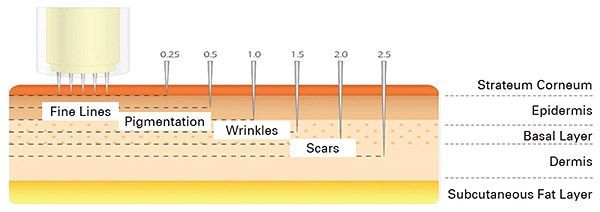Whether you accept it, avoid it or live somewhere in between, insurance coverage has become a defining issue for our profession. Patients increasingly expect to use their benefits, practitioners want to be compensated fairly for their time and expertise, and the system itself remains – at best – fragmented. The encouraging news is that coverage has expanded in meaningful ways. The challenging news is that reimbursement, across the board, remains inadequate.
Popular Ancillary Services for Cosmetic Facial Acupuncture (Pt. 1)
Author's Note: Part 1 of this article discusses gua sha, face cupping and microneedling. Part 2 will feature microcurrent, light-emitting diode (LED) therapy, and the application of ancillary services for enhancing business revenue.
In the Qin Dynasty (221-206 BC), Chinese medical physicians performed mei rong ("beautiful appearance") acupuncture and herbal medical treatments on the empresses' and emperors' concubines to enhance natural radiance, maintain a youthful and lustrous appearance, and delay signs of aging. In 2014, an NCCAOM survey, "Acupuncture Facial Rejuvenation Certification Needs Assessment Survey," reported that according to acupuncturists' responses, 62 percent of their patients had inquired about acupuncture for improving facial aging concerns.

Today, acupuncture for appearance enhancement is one of the fastest-growing specialties among acupuncture professionals in the United States. This modern application of ancient mei rong, commonly referred to as cosmetic acupuncture or cosmetic facial acupuncture, is a recognized alternative and adjunct to well-established Western beauty-enhancing procedures such as neurotoxins, volumizers and surgery. As more traditional Eastern Asian medicine (TEAM) graduates and seasoned practitioners incorporate cosmetic facial acupuncture into their practices, for many, the ability to maintain a lucrative business is of concern. Although improving one's clinical skills with advanced education is always recommended, incorporating adjunctive services can promote professional visibility, boost treatment results, add monetary value to your service menu, and increase revenue. Facial gua sha, face cupping, microneedling, microcurrent and light-emitting diode (LED) therapy are popular adjunct options.
Stone | Color | Property | Function |
| Amethyst | Purple | Cools, soothes skin, releases tension | Reduces tissue inflammation, relaxes muscle tension, soothes skin |
| Aventurine | Green | Relieves stagnation and resolves old patterns | Minimizes wrinkles, reduces tissue stagnation |
| Bian Stone | Black | Antioxidant | Deep penetration for stress relief |
| Jade | Green | Reduces inflammation and redness | Lifting, contouring, improving skin clarity |
| Rose Quartz | Pink | Reduces stagnation and pigmentation | Calms and evens reactive skin, minizines wrinkles, evens skin color |
Facial Gua Sha & Cupping
Rooted in East Asian medicine, facial gua sha (gua: to scrape; sha: sand-like) is an inexpensive and effective cosmetic facial acupuncture treatment. Modern gua sha tools made of jade, amethyst and rose quartz minerals, to name a few, have unique vibratory frequency that resonate with body energies. Stone choice is therefore selected for treatment intention.
Green jade, the most common gua sha stone, is naturally cooling and used for contouring facial tissue. Purple amethyst, rich in negative ions, is selected for reducing tissue inflammation, skin redness and breakouts. Rose quartz, with its calming properties, relieves tension in the face, and is effective for softening skin and resolving wrinkles.
Gua sha tools come in many shapes and sizes. In general, tools with smaller, sculpted edges are used for detailed work in smaller areas (wrinkles along the forehead, and around the eyes and mouth), while larger, broad-based tools are best for wider areas (enhancing cheek volume, softening neck tension).
When treating the face, rather than raising petechia, facial gua sha utilizes light to medium pressure with rhythmic strokes to stimulate lymph drainage, improve circulation of qi and blood, and resolve underlying tissue congestion.
Face Cupping
Cups for face cupping were originally formed from hollowed bones and bamboo. Today, they are primarily made of glass or silicone. Similar to gua sha, when properly suctioned to the skin surface face cupping also improves exterior and interior health.
Benefits of Facial Gua Sha and Face Cupping
- Reduces stagnation by dispersing qi and blood
- Removes cellular waste from the lymphatic system
- Harmonizes tissue fascia and muscles imbalances
- Plumps fine lines and softens wrinkles
- Relieves tension and pain
- Expels wind, cold and/or heat from the skin surface
Facial gua sha and face cupping also have a noted effect on tissue fascia and collagen production. Fascial tissue responds to mechanical stimuli and transmits electrical signals throughout the body. One of the main components of fascia is collagen. Collagen has been shown to have semiconductive, piezoelectric and photoconductive properties in vitro. These electronic currents within connective tissue and fascia can be altered by external influences, such as facial gua sha and face cupping, to cause a physiologic response in localized tissue and distal planes.1

Microneedling
Rooted in ancient TEAM history as "plum blossom," microneedling today is used as a controlled tissue trauma with the intention of stimulating the production of healthy tissue collagen and elastin. Commonly referred to as mesorolling, dermarolling, cutaneous induction therapy, or percutaneous collagen induction, microsized needles driven into the epidermal and superficial dermal layers of the skin encourage the release of growth signals to undifferentiated skin stem cells. These signals also stimulate the rapid growth of new fibroblasts and other wound-repairing cells.
Fibroblasts are one of the primary cells present in skin connective tissue. When stimulated, fibroblasts activate white blood cells to repair the microtrauma created by microneedle insertion, enhance type 1 collagen, promote elastin production, and thicken atrophic skin tissue. Enhanced collagen production provides the visible appearance of thicker, firmer skin; scar reduction; and softening of deep and superficial wrinkles.
Treatment effect is dependent upon the length of the microneedles. Shorter needles penetrate the epidermis to diminish superficial wrinkles and even skin coloring. Longer needles are used for softening deeper wrinkles and minimizing scars.
Rollers vs. Pens
Microneedling rollers and microneedling pens are most effective when combined in a single treatment.
Microneedling Rollers:
- Ideal for large areas and sweeping across the entire face
- Needle range varies from .2-2 mm
- Does not require batteries or electrical outlet
- May or may not require numbing cream
- Price ranges from $20-$50
Microneedling Pens:
- Often a more precise treatment for isolated skin areas and for targeting individual scars or wrinkles
- Needle range varies from .5-2.5 mm
- Often requires batteries or an electrical outlet
- Numbing cream is often required
- Price ranges from $1,000-$4,000
Microneedling Improves:
- Wrinkles
- Acne
- Scars
- Cellulite
- Tissue laxity
- Skin dyschromia
- Pregnancy stretch marks
Current research has led to new advancements in microneedling. According to the work of Singh and Yadav,2 although traditionally used as a collagen induction therapy for cosmetic purposes, microneedling is now widely used as a transdermal delivery system for therapeutic drugs and vaccines.
Practice Pearls
As more and more acupuncture professionals incorporate cosmetic facial acupuncture into their practices, maximizing consumer support may be of concern. Ancillary services are a lucrative and effective adjunct to cosmetic facial acupuncture treatment. Facial gua sha and face cupping devices are relatively inexpensive to purchase, can be efficiently applied, and are effective for reducing tissue inflammation, face sculpting, and improving complexion. Microneedling, a larger initial investment, yields effective longer-term benefits.
References
- Langevin HM. Connective tissue: a body-wide signaling network? Med Hypotheses, 2006;66(6):1074-7.
- Singh A, Yadav S. Microneedling: advances and widening horizons. Indian Dermatol Online J, 2016 Jul-Aug;7(4):244-54.
General Resources
- Ahn AC, Grodzinsky AJ. Relevance of collagen piezoelectricity to "Wolff's Law": a critical review, Med Engineering & Physics, 2009;31(7):733-741.
- Bordoni B, Simonelli M. The awareness of the fascial system. Cureus, 2018;10(10):e3397.
- Shuster S, Black MM, McVitie E. The influence of age and sex on skin thickness, skin collagen and density. Br J Dermatol, 1975 Dec;93(6):639-43.



